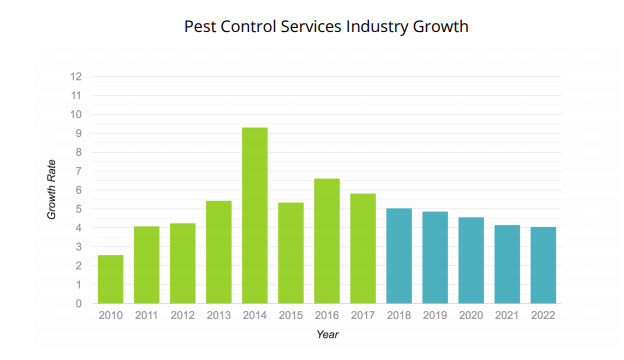Industry forecast, profit drivers, and inherent risks for pest control services
Vertical IQ, an easy-to-use online service that focuses on the financial aspects of how firms operate in a particular industry, quickly turns you into an industry expert with hard-to-find intelligence on small- and medium-sized businesses. Users can dive into the details of risks, trends, cash flow, operations, and financial challenges inherent to niche businesses in nearly 400 different industries.
To give you an example of the type of content included in Vertical IQ, the following covers many of the unique areas of pest control services, which specialize in residential or nonresidential services, including the industry forecast, business size and structure, profit drivers, and risks to watch out for.
Industry forecast for pest control services
For the U.S. pest control services industry, sales are forecast to grow at a 4.74% compounded annual rate from 2016 to 2022, faster than the growth of the overall economy. Vertical IQ forecasts are based on the Inforum interindustry economic model of the U.S. economy. The Interindustry Economic Research Fund Inc. prepared Inforum forecasts.

Industry size and structure
The average pest control services provider operates out of a single location, employs 10 workers, and generates over $1 million annually.
- The pest control services industry consists of about 11,700 companies that employ about 119,000 workers and generate about $12.5 billion annually.
- The industry is concentrated at the top and fragmented at the bottom; the top four firms account for about 28% of industry sales. The majority of pest control service providers are small, independent companies or franchises.
- Large companies include Rollins (Orkin) and divisions of ServiceMaster (Terminix).
- The business structure of pest control services firms is 20% corporations, 59% S corporations, 11% individual proprietorships, and 10% partnerships.
- Fourteen percent of pest control services firms are female-owned, and 20% are minority-owned.
Profit drivers
- Growing customer base
Pest control companies provide one-time and recurring treatments to residential and nonresidential customers. Increasing the number of customers with annual pest control contracts provides a stable revenue stream and helps firms efficiently schedule customer services. Companies rely on referrals for new business leads and also invest in local advertising and direct mail programs to reach new customers. They also develop relationships with builders and property management companies to secure termite control and other business.
- Efficiently scheduling technicians
Labor is the most significant cost for pest control companies, so they try to maximize the productivity of their technicians. Efficient scheduling and routing of jobs can allow technicians to complete more customer treatments per day. Companies may invest in route scheduling software and GPS systems to boost technician productivity. Having multiple residential contract customers in the same neighborhood can minimize travel time, so companies may offer discounts through homeowner associations or use direct canvassing and referrals to build a critical mass of nearby customers.
- Managing staff levels
Due to seasonal swings in demand for pest control services, companies face challenges in matching staffing levels to customer demand. Pest control companies typically hire part-time workers to handle peaks in demand during the spring and summer months and let them go during the slow winter months. However, firms need to maintain experienced technicians who are licensed in the proper application of pesticides, so they are reluctant to let go of good performers. Having annual pest control contracts with customers can help smooth cash flow and allow firms to maintain a permanent staff year round.
Risks to watch out for
- Seasonality
Demand for pest control is seasonal, and driven by increases in pest activity. Pest problems tend to occur more frequently during the spring and summer, as bugs seek moisture and warmth. Termites can swarm in the spring, summer, or fall, depending on location and the timing of the change of seasons. Extreme weather, such as droughts, can reduce the pest population in a particular area for an extended period.
- Hazardous substances
Pest control often involves the application of toxic chemicals that have the potential to harm humans, pets, plants, or the environment. The risk of harm varies depending on the level of toxicity and exposure. Application can create both acute toxicity (short-term exposure) and chronic toxicity (long-term exposure). Because technicians are exposed to pesticides regularly, most receive special training and equipment to minimize risk. Misapplication can result in personal injury or property damage.
- Competition
Competitors for pest control service providers involve companies in a range of industries, including cleaning and sanitizing services, facilities services, and lawn care. By offering pest control as part of a portfolio of services, large multidisciplinary competitors attract commercial customers who prefer to deal with a single source. In addition, some customers (particularly residential customers) will attempt do-it-yourself (DIY) pest control to save on costs. DIY customers typically lack technical expertise and access to commercial strength pesticides.
Conclusion
As you can see, pest control service providers have a wealth of unique challenges inherent to their industry. To get more details on the industry, download the complete Vertical IQ sample report.
To learn more about the Vertical IQ platform and how it does the heavy lifting for you in terms of the analysis of an industry and synthesizing the data into a readable report, schedule a demo. Subscribers have access to more than 400 industry profiles such as beer distributors, architectural services, chiropractic clinics, commercial printers, and many more. Click here for a list of all industries covered.
